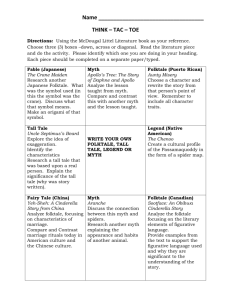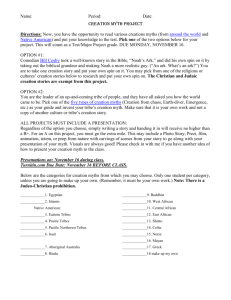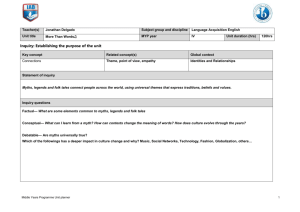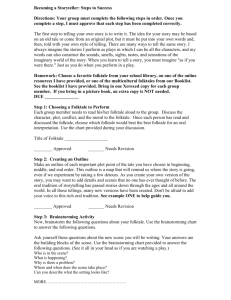Native American Mythology
advertisement
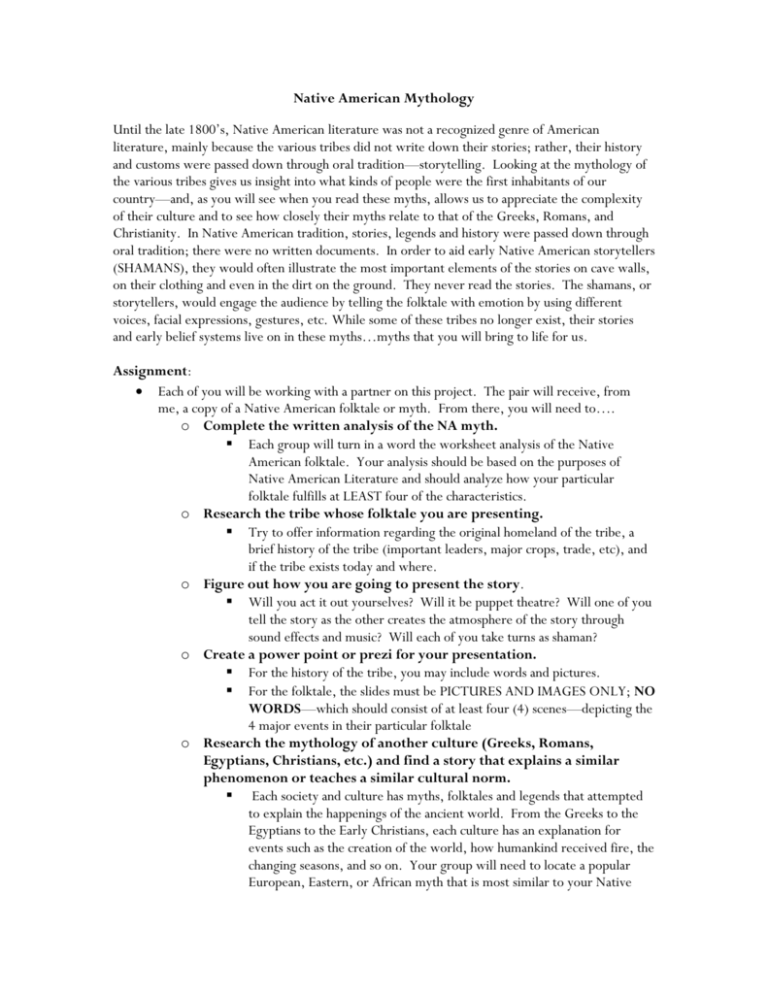
Native American Mythology Until the late 1800’s, Native American literature was not a recognized genre of American literature, mainly because the various tribes did not write down their stories; rather, their history and customs were passed down through oral tradition—storytelling. Looking at the mythology of the various tribes gives us insight into what kinds of people were the first inhabitants of our country—and, as you will see when you read these myths, allows us to appreciate the complexity of their culture and to see how closely their myths relate to that of the Greeks, Romans, and Christianity. In Native American tradition, stories, legends and history were passed down through oral tradition; there were no written documents. In order to aid early Native American storytellers (SHAMANS), they would often illustrate the most important elements of the stories on cave walls, on their clothing and even in the dirt on the ground. They never read the stories. The shamans, or storytellers, would engage the audience by telling the folktale with emotion by using different voices, facial expressions, gestures, etc. While some of these tribes no longer exist, their stories and early belief systems live on in these myths…myths that you will bring to life for us. Assignment: Each of you will be working with a partner on this project. The pair will receive, from me, a copy of a Native American folktale or myth. From there, you will need to…. o Complete the written analysis of the NA myth. Each group will turn in a word the worksheet analysis of the Native American folktale. Your analysis should be based on the purposes of Native American Literature and should analyze how your particular folktale fulfills at LEAST four of the characteristics. o Research the tribe whose folktale you are presenting. Try to offer information regarding the original homeland of the tribe, a brief history of the tribe (important leaders, major crops, trade, etc), and if the tribe exists today and where. o Figure out how you are going to present the story. Will you act it out yourselves? Will it be puppet theatre? Will one of you tell the story as the other creates the atmosphere of the story through sound effects and music? Will each of you take turns as shaman? o Create a power point or prezi for your presentation. For the history of the tribe, you may include words and pictures. For the folktale, the slides must be PICTURES AND IMAGES ONLY; NO WORDS—which should consist of at least four (4) scenes—depicting the 4 major events in their particular folktale o Research the mythology of another culture (Greeks, Romans, Egyptians, Christians, etc.) and find a story that explains a similar phenomenon or teaches a similar cultural norm. Each society and culture has myths, folktales and legends that attempted to explain the happenings of the ancient world. From the Greeks to the Egyptians to the Early Christians, each culture has an explanation for events such as the creation of the world, how humankind received fire, the changing seasons, and so on. Your group will need to locate a popular European, Eastern, or African myth that is most similar to your Native American folktale. This folktale may be presented to the class as part of your power point/prezi and slides/stops may include words to help tell the story. o Present the Tribal history, then your NA myth to the class in the style of a tribal shaman, offer a brief comparison/contrast between the NA myth and the corresponding myth from another culture, and finally, discuss which characteristics of Native American Literature your folktale fulfills. The presentation should consist of the following The presentation should start off with a brief description of the tribe whose folktale you are presenting. From there, you will present your Native American myth. Remember, you and your partner are the shamans of our tribe—YOU CANNOT READ THIS TO US. You must become storytellers. The tribes passed down their history, their explanations of natural phenomena, hints for planting crops and hunting animals, and their religious beliefs/morality through these stories. So please, make this interesting! You will then present the similar myth from another culture (this may be read to us, or you can just give us a brief outline—you do not have to bring this myth to life) Start with a brief telling of the other myth—what culture it came from and the basic premise of the story. Then offer several points of comparison/contrast between your group’s Native American myth and the myth you chose from another culture. Remember that each myth does not have to match your folktale exactly—we are looking for both similarities and differences between the cultures. Draw some conclusions about the similarities and differences between these two cultures based on the myths you chose. Why does the olive tree or the laurel mean so much to the Greeks, but corn seems to be at the center of so many NA myths? Think about what we can glean from these two widely different cultures based on their mythology. Finally, explain in what ways your Native American Myth fulfills the purposes of Native American Literature as outlined in your notes. Both partners should have an equal role in the presentation of information. Rubrics for the presentations will be distributed before presentations begin on ______________.

